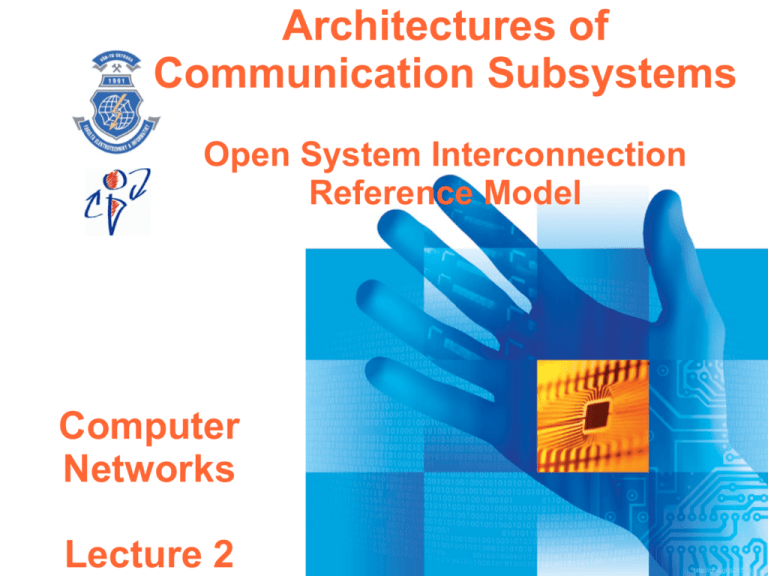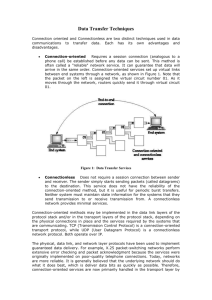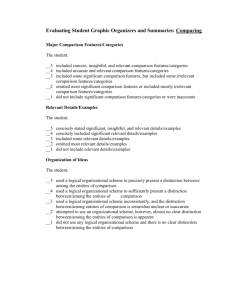Transport Layer
advertisement

Architectures of Communication Subsystems Open System Interconnection Reference Model Computer Networks Lecture 2 http://goo.gl/pZE5o8 Connection-Oriented versus Connectionless Communication 2 Connection-Oriented Communication A communication session is established before the data transfer starts and terminated after the transfer finishes System resources and control structures are reserved/created for the upcoming data transfer on the intermediate network devices / on the transmitter and receiver Stateful – scalability problem Delivers a data stream in the same order it has been sent Does not necessarily imply reliable data transfer 3 Connectionless Communication A message can be sent from a transmitter to any receiver without any prior agreement The transmitter may alternately send messages to several receivers the receiver identification is contained in the message Messages are treated by the network as independent entities they may be received out of order any a message may be lost Stateless no state information has to be kept on the network devices nor the receiver and transmitter 4 Implementation of the Connection-Oriented Communication Network technology level Connection-oriented networks have to be instructed to create a circuit to a particular receiver before the transmission starts and tear it down after finished either the physical or the virtual circuit The intermediate network elements have to allocate resources + establish the data path and provide the connection identifier to the transmitter Transmitter/Receiver protocol level Implemented on the software level The (logical) connection is represented by the current state of data structures on the transmitter and receiver The underlying network technology can be either 5 connection-oriented or connectionless Layered Communication Subsystem Architecture 6 Layered Communication in Practice 7 Advantages of the Layered Architecture Decomposes the (comprehensive) problem of communication between systems to smaller and more easily understandable sub-problems Well-defined modules (services) Well-defined interfaces (Service Access Points + Primitives) Layers may be treated as modules allows to replace the layer implementation easily 8 Communication Interfaces between Layers and Peer-to-peer Protocols 9 Peer-to-Peer Protocol Defines the rules of the cooperation between entities of the same layer at different systems 10 Service Provider Entities and Service Access Points Layer N Layer N Layer 3 Layer 3 Layer 2 Layer 2 Layer 1 Layer 1 11 Service Provider Entities The layer consists of one or multiple entities, that implement and provide the services of the layer may use the services provided by entities of the layer bellow for that Entities communicate with entities of the same layer on the peer system 12 Service Access Point Defines rules of the communication between adjacent layers Software interface Operations defined as service primitives 13 SAP Primitives Used to Communicate between Service Provider & Service User Request – request of a particular service of the lower layer Confirm – confirmation of the service to the service user (the upper layer) Indication – information of the service user about the occurrence of an event Response – the response of the service user to the indication from the service provider Defined as abstract operations, no implementation details are specified 14 ISO Open System Interconnection Reference Model (OSI RM) ISO IS 7498, ITU-T X.200 15 Open System System – a standalone unit capable to process the information and communicate with other systems Open system specifications describing its architecture are publicly available all systems that suit the specification are mutually inter-operable OSI-RM treats the open system as an abstract model of the real open system the particular implementation is not prescribed 16 ISO-OSI Reference Model A general layered model of the open system interconnection Specifies general responsibilities (functions) of individual layers services provided to the layer above and services expected from the layer bellow just conceptually, not the exact technical specification The goal was to provide a common framework for standardization of networking subsystems of the interconnected open systems today, the model is used much more as a layering scheme and a terminology standard 17 Terminology of Layered Communication The information to be passed to the peer entity is exchanged between layers through SAPs as Service Data Units (SDU) SDU is accompanied with Interface Control Information (ICU) thats provides the additional information concerning the SDU (e.g. the length) and the requested service to the lower layer The peer-to-peer protocol exchanges Protocol Data Unit (PDU) between peer entities PDU contains the payload taken from the upper layer and the Protocol Control Information (header/trailer) Every layer treats PDU of the upper layer as transparent data (SDU) and adds its own control information 18 (header/trailer) Relation between PDU and SDU 19 Picture from http://www2.themanualpage.org/networks/images/sdu-pdu.gif Encapsulation of PDUs in Practice 20 Layers of OSI RM 1.Physical Layer 2.Data Link Layer 3.Network Layer 4.Transport Layer 5.Session Layer 6.Presentation Layer 7.Application Layer The number of layers (7) is a result of a trade-off between the alternative suggestions If the service provided by some layer is not required in the particular system implementation, the “null” layer implementation may be provided 21 Physical Layer (1) Takes care of the physical bit stream transfer between (neighboring) systems Point-to-point or multi-point connections Full duplex or half duplex operation Defines the interaction of (a single) device with a medium physical and electrical parameters of the medium interface includes the exact specification how are data represented on the medium signal levels, data encoding and modulation may include media access control 22 Physical Layer (2) Services provided to the upper layer Transmission of the “raw” bit stream (incl. Eventual markers, such as frame delimiters, idle patterns etc.) physical connection establishment and termination Examples: RS232, V.35, Ethernet 10BaseT, Ethernet 100BaseTX 23 Data Link Layer Provides (one or more) logical connection(s) for network layer entities on the neighboring systems (including connectionless service) Services provided to the upper layer: Formatting and recognition of data frames addressing of communication participants Identification of the connection endpoints (network layer entities) – e.g. the protocol identification Error detection/error correction, error indication Establishment, maintenance and termination of the logical connections (sliding window) Flow control The link layer of LAN standards is often split to MAC and LLC sublayers which allows to unify handing of various network technologies with different MAC sublayers using the common LLC sublayer. 24 Examples: LLC 802.2, PPP, Frame Relay Network Layer Allows to overcome the differences between various network technologies (either connection-oriented or connectionless) and establish the universal service interface Provides data transfer between non-neighboring systems using intermediate systems Functions and protocols for hop-by-hop data transfer, routing Routing have to be applied during transfer of individual packets or during creation of the (virtual) circuit Hides the network topology (including the routing problem) to the transport layer Provides unique system addressing in the scope of the whole internetwork Services provided to the upper layer: 1. Connection-oriented network service – reliable 2. Connectionless network service – unreliable (e.g. transfer of IP packets in the Internet) Examples: IP, IPX - connectionless, X.25 - connection-oriented Transport Layer (1) Provides a transparent (reliable) data transfer between two transport layer entities (end users) Establishes addressing of transport-layer entities in scope of a device with the single network address Multiple transport session may exist between two systems in parallel allows to multiplex multiple connections across a single virtual circuit Takes care of segmentation and reassembly, error correction and flow control Provides both connection-oriented and connectionless service to the upper layer 26 regardless of the type of the underlying network Transport Layer (2) Stands between the network infrastructure and endsystems that use it Transport session is established directly between end-system transport entities, intermediate systems do not participate Examples: TCP and UDP protocols 27 Session Layer Organizes and synchronizes the dialog between peer entities of the presentation layer Services provided to the upper layer: Dialog control – simplex, alternating or duplex communication Flow control Normal, urgent and delayed message transfer Checkpoints (transactions) multiplexing/demultiplexing of the application layer session to one or multiple transport layer session (1:N,N:1) Examples: Remote Procedure Call (RPC) Sharing of local disks or printers the transport layer session is established just for the duration of the particular data transfer, the session layer session exists for the whole time the remote disk is connected Presentation Layer Unifies the way how the information passed between application-layer entities is represented Binary representation of data types and characters, utilized data structures and formats Provides mechanism for agreement of message syntax and its further modification The presentation layer deals only with the structure of messages, their semantics is known only to the application layer Functions of the layer Appointment of the message syntax Transfer of messages with the transformation of syntax and data formats Examples Specifications of character and image representation: ASCII/EBDIC, TIFF/JPEG/..., Specifications of binary data representations (XDR, CDR/GIOP, ASN.1+BER) Bit and byte ordering (LSB first/MSB first),Hi-Lo/Lo-HI Data encryption, compression 29 Application Layer Provides access to the communication subsystem to application programs Specifies the format in which application programs have to provide/accept data Provided Services: Determination of the identity and availability of communication partner(s) Appointment of functions required from lower layers Specification of the necessary QoS, determining resource availability Selection of the dialog mode Specification of responsibilities concerning error correction and data consistency Agreement of the message syntax Examples network applications (e-mail, file transfer, …) any network-enabled application software Common Application Services (CASE) Specific Application Services (SASE) 30 Services Provided by Multiple Layers Some functions are implemented in more than one layer simultaneously (in various extends) and operate at the same time in various levels of the abstraction Error correction/detection Flow control fragmentation / reassembly Mapping of session(s) to lower-layer session(s) 1:1 1:N N:1 31 The Common Names of PDUs of Individual Layers Application-session layer: messages Transport layer: segments, datagrams Network layer: packets Data link layer: frames 32






